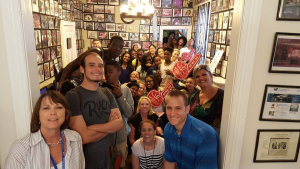The efficacy of a trauma-informed methodology for Hopeworks ‘N Camden, New Jersey
Principal Investigator: Natasha O. Fletcher, Ph.D.
Research Assistant: Asia N. King
- Evaluate the impact of a trauma-informed methodology / sanctuary approach adapted by the youth-centered nonprofit organization Hopeworks N Camden,
- Better understand how youth that experience chronic stress accumulated by living in high-poverty neighborhoods can be served effectively.
 Hopeworks is a nonprofit organization in Camden, NJ, one of the Nation’s most distressed cities, which has been working for over 15 years with youth ages 14-23 to get back in school and find a safe pathway to their future. As part of its program, it runs three businesses, offering training in web site design, development, maintenance and hosting services, Geographic Information Systems (GIS), and Salesforce administration. These businesses help to generate over 50 youth jobs a year. As part of its youth development resources, the organization provides youth with support for getting GED’s, completing college and financial aid applications, developing professional, marketable skills for internships in web design, GIS data mapping, or Salesforce administration. Through internal internships youth can practice these technical skills while also practicing professional skills needed for future employment.
Hopeworks is a nonprofit organization in Camden, NJ, one of the Nation’s most distressed cities, which has been working for over 15 years with youth ages 14-23 to get back in school and find a safe pathway to their future. As part of its program, it runs three businesses, offering training in web site design, development, maintenance and hosting services, Geographic Information Systems (GIS), and Salesforce administration. These businesses help to generate over 50 youth jobs a year. As part of its youth development resources, the organization provides youth with support for getting GED’s, completing college and financial aid applications, developing professional, marketable skills for internships in web design, GIS data mapping, or Salesforce administration. Through internal internships youth can practice these technical skills while also practicing professional skills needed for future employment.
In 2012, the Hopeworks leadership implemented a trauma-informed methodology, using the Sanctuary model (Bloom, 1997). Becoming a certified sanctuary organization has meant a radical shift in values, priorities, and interactions to a “trauma framework”. Realizing that without addressing the unresolved traumatic issues in a youth’s life–especially as they manifest in habitual patterns of protection, e.g. disengagement, anger, emotional eruptions, reenactment, youth will not be able to take full advantage of opportunities in their lives
This study provides an in-depth examination into the organization and evaluates the efficacy of a trauma-informed organizational model. As such, it is meant to help the organization inform best practices, contribute to an understanding of its history, the efficacy of its programs, perceptions of past and present participants, employees, and leadership.
In addition, this research helps other organizations to inform their best practices and to determine whether a trauma-informed organizational model should be adapted.Research Design
This research is based on an in-depth case study (Yin, 2009). The data collected from leadership, staff, and past and present program participants, along with secondary data relating to the organization are analyzed for themes and synthesized accordingly. Given the exploratory nature of this research, the resulting measurement and instrumentation are iterative and develop as data are collected. Data collection and analysis are closely linked and guided by initial concepts and developing understandings. In-depth, semi structured interviews are transcribed from digital audio into text by the researcher and analyzed via content analysis to explore responses in relation to other key data collected separately, such as organizational materials and historical data. All data are triangulated and culminate in the research report below.
